Exploring Four-Line Kites: Maneuverability in Kiteboarding
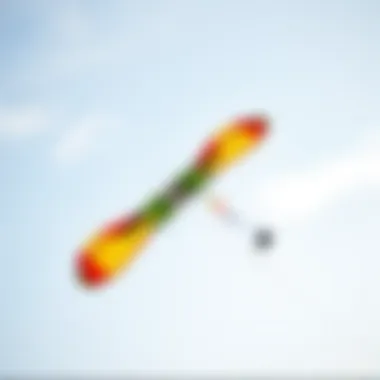
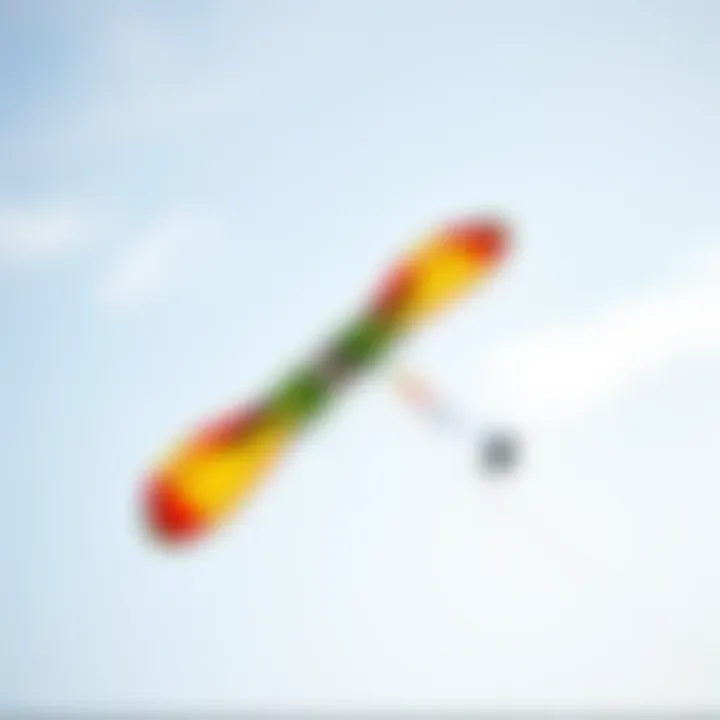
Intro
Kiteboarding is not just a sport; it's an exhilarating embrace with the wind and sea, a dance between rider and nature. Among the various types of kites available, four-line kites are in a league of their own. This article examines their intricate world, shedding light on what sets them apart from two-line kites. Whether you’re a novice eager to catch your first breeze or a seasoned rider seeking to refine your skills, understanding four-line kites is essential for maximizing your kiteboarding experience.
Woven into the narrative are discussions about the unique design features of four-line kites, how they've evolved, and their advantages in terms of control and maneuverability. To best utilize these kites, we’ll explore gear essentials tailored to various skill levels and provide insider tips that every kiteboarder should know.
Moreover, safety is paramount in every ride; this guide doesn’t skim over precautions and advancements in technology meant to keep kiteboarders safe. So grab your gear, and let’s engage with the fascinating details of four-line kites in kiteboarding.
Gear and Equipment
Essential Kiteboarding Gear for Beginners
Starting with the basics is key for any budding kiteboarder. It’s important to have the right equipment to set a solid foundation for riding. Here’s a list of essential gear:
- Four-Line Kite: Choose a reliable model like the North Atmos. Ensure you’re comfortable with the size that suits your skill level and conditions.
- Control Bar: This is your connection to the kite. Look for one with easy-to-use features. A decent choice would be the Cabrinha Overdrive.
- Harness: A seat or waist harness like the Mystic Warrior can prevent fatigue and enhance your control while riding.
- Board: A beginner-friendly board like the Duotone Whip might just do the trick—solid yet forgiving.
- Safety Gear: A helmet, impact vest, and a beach towel may seem minor but they play a significant role in your overall safety and comfort.
Advanced Equipment for Experienced Riders
For the seasoned kiteboarders, taking things up a notch requires a deeper dive into specialized equipment. Here are some essentials that the advanced riders might consider:
- High-Performance Kite: Kites such as the Slingshot Ghost are designed for movement at speed, ideal for tricks and advanced maneuvers.
- Custom Control Bars: Advanced bars come with features like adjustable width that can enhance your control and precision in rough waters.
- Lightweight Boards: Boards like the Naish Hero provide agility, allowing experienced riders to carve through waves with ease.
- Wave-Specific Gear: If you’re in it for the waves, consider getting a kite surfboard, tailored for wave riding.
"Gear may not make the rider, but the right gear can certainly elevate the experience."
Ensuring you have the right tools in your kit is half the battle won in kiteboarding. All the gear listed here not only enhances your control but invites you into a world of exciting possibilities at sea.
Techniques and Tips
Basic Riding Techniques for Newbies
Getting comfortable on the board is the first milestone for newbies. Here are a few techniques to help you find your balance, so to speak:
- Body Drag: Start with body dragging before getting on the board. This helps you understand how the kite reacts to wind pressure.
- Starting Position: Sit with one knee on the board and the other leg extended behind you.
- Controlled Launch: Mastering how to launch your kite safely is crucial. Practice in a controlled environment until it feels natural.
Expert Tricks to Elevate Your Skills
Once you’re over that initial hump, the real fun begins. Here are some tricks that can help you dazzle onlookers while boosting your skillset:
- Jumping: Focus on generating speed and pulling on the back of the bar to lift off.
- Spins: Begin with a basic 360-degree turn and build up to more complex rotations.
- Kite Loops: As you gain confidence, learn to loop your kite while jumping for thrilling aerial maneuvers.
Each technique or trick is built on practice and a solid understanding of kite dynamics. Embracing the learning curve and respecting the wind will get you far, ensuring every session is both safe and enjoyable.
The Concept of Four-Line Kites
Understanding the concept of four-line kites is paramount for anyone delving into kiteboarding. These kites represent a significant advancement in the sport, offering not just additional lines, but a transformative approach to flying that allows for finer control and dynamic maneuvers. In the world of kiteboarding, where the balance between thrill and safety is delicate, having more options at the rider's fingertips can spell the difference between a smooth ride and a harrowing experience.
Four-line kites come equipped with an additional set of lines, generally used for controlling the kite’s position and movement more directly. This setup enables enhanced responsiveness to wind shifts, giving kiteboarders the ability to adjust their course swiftly. The added lines also facilitate control over the angle of attack, making it easier to perform tricks and maintain stability amidst variable environmental conditions. The appeal lies not only in their functional advantages but also in the ability to push the boundaries of what kiteboarding can offer.
Additionally, four-line kites exhibit a myriad of designs tailored for different skill levels and conditions, making them suitable for a diverse set of riders. This adaptability is crucial as it caters to a range of experiences, from novices just starting out to seasoned pros aiming to master complex aerial feats. Knowing the intricacies of these kites is essential in forging a path through the sport, ensuring that each rider can find their niche and flourish.
"A four-line kite can become an extension of the rider, facilitating a synergy that enhances experience far beyond the mere act of flying."
In this section, we'll dive deeper into two key aspects: the basic workings of four-line kites and how they differ fundamentally from their two-line counterparts.
Design Features of Four-Line Kites
The design features of four-line kites play a critical role in the overall performance and user experience of kiteboarding. Understanding these elements not only helps kiteboarders select the right kite but also enhances their riding capabilities. Four-line kites are often celebrated for their agility and responsiveness compared to their two-line counterparts. This section unpacks the key design aspects that contribute to their effectiveness in varying conditions.
The Structure of Four-Line Kites
Four-line kites are built with precision, exhibiting a sophisticated structure that enables advanced control. The configuration includes four lines—two for steering and two for power adjustment—which grants riders the ability to manipulate the kite's angle in the wind more effectively. This setup allows for immediate response to input from the rider.


- Four-Line System: The extra lines facilitate practice in trick execution. Riders can perform jumps and spins with renewed confidence, knowing that better control will lead to smoother landings.
- Bridle System: A well-designed bridle system aids in distributing the pressure across the canvas evenly. This structure maintains stability even during gusty winds, making it a favored choice for those navigating variable conditions.
Understanding the essential structure of these kites is vital, as it lays the groundwork for exploring their unique functionalities.
Material Innovations
In recent years, advancements in material technology have significantly impacted the design of four-line kites. The shift towards lightweight yet durable materials means that kite designers can enhance their products without adding unnecessary weight.
- Ripstop Nylon: This material resists tearing, significantly extending the kite's lifespan, and is often used for the sail. The lightweight qualities help in achieving better lift.
- Dyneema Lines: These lines are known for their strength and low stretch characteristics. They allow for sharper feedback and responsiveness while navigating through various maneuvers.
Innovative materials not only provide improved performance but also contribute to a kite's sustainability. Manufacturers are increasingly focusing on eco-friendly options, which play a crucial role in fostering responsible kiteboarding practices.
Aerodynamics and Performance
The design of four-line kites heavily emphasizes aerodynamics, a factor that can make or break a rider's experience on the water. The efficiency with which these kites slice through the wind directly affects speed and maneuverability.
- Wing Shape: The contour of a four-line kite is often more elliptical compared to two-line kites. This shape helps in maximizing lift while minimizing drag, providing a smoother ride in both light and strong winds.
- Control Surfaces: Many four-line kites feature adjustable control surfaces that allow riders to fine-tune the angle of attack. This flexibility makes it easier to adapt to changing wind conditions, ensuring that kiteboarders can maintain optimal performance at all times.
"Aerodynamics is the name of the game in kiteboarding, where even the slightest tweak in design can lead to a world of difference in performance."
The combination of all these design features culminates in a kite that not only empowers riders to perform with elegance and flair but also ensures safety and stability. By paying attention to these design intricacies, kiteboarding enthusiasts can choose kites that truly elevate their experience and allow them to enjoy the thrills of the sport to the fullest.
Advantages of Four-Line Kites
Four-line kites have taken the kiteboarding scene by storm, transforming how enthusiasts interact with the wind and water. These kites present several advantages that cater to both newcomers and experienced boarders. Understanding these benefits provides a solid foundation for making informed decisions in the world of kiteboarding.
Enhanced Maneuverability
One of the most notable features of four-line kites is their enhanced maneuverability. Unlike two-line kites, four-line designs allow for more precise control over various movements. This is largely due to the extra lines, which help modify the kite's angle of attack and adjust its power.
For example, when attempting sharp turns or quick transitions, the extra lines enable more immediate adjustments. Riders can direct the kite without losing the pivotal connection with the board. This type of responsiveness is vital, especially during gusty conditions, which can often throw off balance.
Advantages of this maneuverability include:
- More fluid navigation: Riders can weave through obstacles or perform quick dodges with ease.
- Improved jump height: Enhanced control allows for better lift when launching into the air.
- Finer tuning: Subtle adjustments can be made regarding kite steering, allowing for customized riding styles.
Improved Control for Advanced Maneuvers
Advanced maneuvers require different techniques, and four-line kites accommodate this need efficiently. The additional lines significantly give riders more nuanced control during complex tricks and flips. For those determined to master high-level skills such as the backloop or megaloop, four-line kites are particularly beneficial.
This ability to manage the kite dynamically while executing advanced moves realizes critical advantages:
- Smoother transitions: Moving from one trick to another becomes seamless due to improved line management.
- Increased safety: Stronger control helps mitigate risk, allowing riders to perform high-stakes moves with confidence.
- Performance optimization: The level of precision attained with these kites means even slight adjustments can result in notable improvements in performance.
"With four lines at our disposal, it feels as if we are communicating directly with the kite. Each pull and release prompts an immediate response, creating a harmonious dance of rider and kite."
Adaptability in Variable Conditions
Nature can be unpredictable, and four-line kites are designed to thrive in fluctuating weather conditions. The construction of these kites enables them to maintain stability even when winds are inconsistent. The two-point adjustments mean that a rider can quickly switch between power and speed, adapting as the conditions change.
Consider the following elements of adaptability:
- Wind range flexibility: These kites operate effectively across a broader wind range, giving riders more opportunities to hit the water.
- Enhanced stability: The additional lines create even pressure across the kite, minimizing the risk of collapse during wild gusts.
- Resilience during storms: When storms kick up, four-line kites can often handle rough conditions that may otherwise thwart less capable designs.
For kiteboarders keen to extend their riding time and maintain performance quality under a variety of conditions, four-line kites represent an invaluable asset.
In summary, the advantages of four-line kites go beyond mere enhancements; they significantly influence the ease of navigation, control during advanced maneuvers, and adaptability to changing weather. Each benefit plays a pivotal role in refining the kiteboarding experience, making it essential for enthusiasts to consider these elements as they select their gear.
Selecting the Right Four-Line Kite
Choosing the right four-line kite can feel as daunting as picking the right fishing lure on a barren lake. The options can be overwhelming, and making a poor choice can mean settling for an experience that’s less than thrilling. Getting it right, on the other hand, opens the door to exhilarating rides and impressive performance on the water.
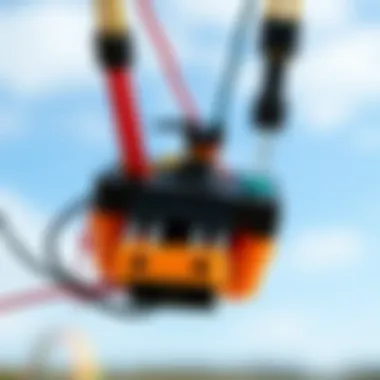
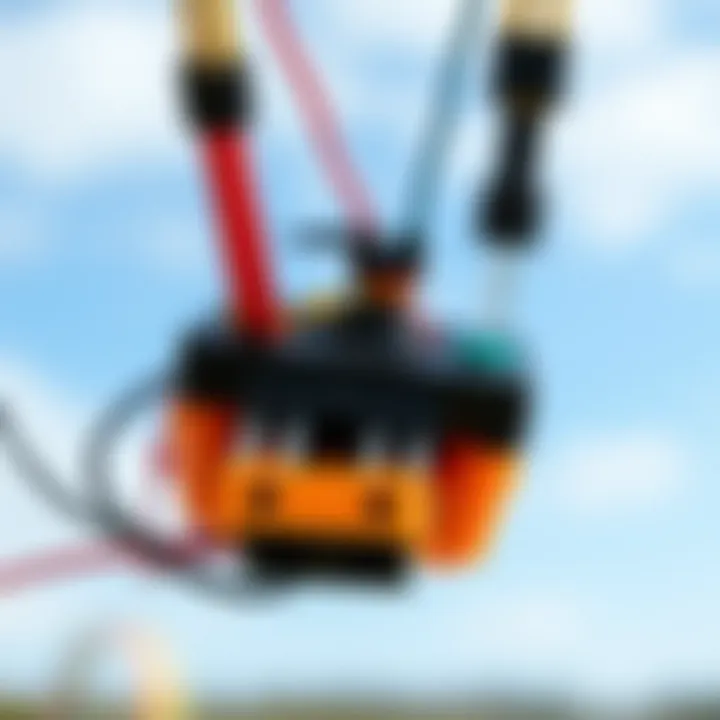
Consider this: the kite needs to match not just the conditions of the water and wind, but also the skill level of the rider. Wrapping your head around this is crucial, as it directly affects how you will navigate through your adventures on the waves.
Factors to Consider
When deciding on a four-line kite, keep several elements in mind:
- Skill Level: Are you a novice still grappling with the basics, or an experienced hand adept at tricks? Your skill set should guide your selection. Beginners usually benefit from kites that offer stability and ease of control, making it easier to learn.
- Wind Conditions: Know the typical wind patterns at your chosen location. Some kites excel in lighter breezes, while others are designed to dominate in stronger winds. This factor helps you not just with the ride, but also with safety.
- Kite Size: The size impacts everything from lift to maneuverability. Bigger kites catch more wind but may be harder to control, particularly for newcomers. Considering your weight and height can help in picking the right size. Often, a medium kite serves as an excellent all-rounder for different wind conditions.
- Construction Quality: The kite should be made from durable materials that can withstand the wear and tear of being up in the sky and splashing against water. Look for kites employing the latest advancements in materials to ensure longevity and performance.
- Budget: This one usually takes the wind out of many sails. Determine what you can afford. High-quality kites can be an investment, but there are also excellent options available at more budget-friendly prices.
"The best kite is not always the most expensive one; it’s one that fits like a glove for the rider’s style and conditions."
Recommendations for Beginners
Starting out in kiteboarding can feel like diving into the deep end, but the right equipment makes learning smoother. Here are a few kites that tend to float to the top for beginners:
- Wainman Hawaii Bunny: This kite is celebrated for its good stability and consistent performance in various winds. Its forgiving nature allows new riders to build confidence without feeling overwhelmed.
- AIRUSH Switch: Known for its reliability, the Switch provides easy handling. It features a medium aspect ratio that aids in flight control, essential for those still learning the ropes.
- Duotone Neo: This is a versatile kite that performs well in both light and strong winds. Designed with a simple approach in mind, it helps beginners focus on mastering the basics before moving onto more complicated maneuvers.
Advanced Options for Experienced Riders
For experienced kiteboarders, the choices expand to kites offering precision in movements and performance in varying conditions. Consider these options:
- Naish Pivot: A high-performing kite favored by many pros due to its responsiveness and ability to handle aggressive tricks. Its performance in varying wind conditions is commendable.
- Slingshot RPM: Renowned for its versatility, the RPM transitions smoothly from waves to freestyle. The depower feature serves riders with high ambitions, allowing rapid turns and flips.
- Cabrinha Switchblade: This kite is engineered for optimum performance across all conditions and boasts a powerful lift, making it a popular choice among seasoned professionals.
Ultimately, the right kite can make the difference between a ho-hum day at the beach and a breakthrough moment on the water. Whether you're a newbie or a seasoned rider, investing thought into your kite selection will only amplify the thrill of kiteboarding.
Techniques for Using Four-Line Kites
Understanding how to effectively use four-line kites is crucial for maximizing your kiteboarding experience. Techniques specifically tied to these kites can greatly enhance performance and safety during your rides. Whether you’re just starting out or are an experienced kiteboarder, honing your skills in this area can make all the difference. The way these kites are designed allows for advanced control and maneuverability, which is essential for mastering various riding conditions. In this section, we will explore basic flying techniques, advanced tricks, and ways to troubleshoot common issues.
Basic Flying Techniques
Every kiteboarder must first get the grasp of basic flying techniques when it comes to four-line kites. These kites require a bit more finesse than two-line counterparts.
- Launch and Land: Getting your kite into the air requires precise movements. Ensure the lines are clear and untangled. Utilize a steady wind, and keep your kite at a slight angle in the wind window to lift it smoothly.
- Controlling the Power: Pulling in on the back lines will allow you to steer and power down your kite. Conversely, pulling the front lines increases lift. Familiarity with these controls is vital. Practice makes perfect, so take time to feel the varying responses.
- Navigating the Wind Window: Understanding the wind window is essential. Keep your kite flying in the middle, as this maintains optimal power. If you fly too downwind, the kite will lose lift. Always be aware of your surroundings and adjust your position accordingly.
- Body Positioning: Keep your body low and centered, with knees bent. This position allows for better control and adaptability to the forces from the kite. Lean back slightly to counteract the pull when power increases.
Executing Advanced Tricks
Once you master the basics, it's time to delve into executing advanced tricks. Four-line kites really shine here as they give you the control you need to pull off high-flying stunts.
- Jumping High: To achieve impressive jumps, utilize the kite’s lift by pulling back on the lines while simultaneously edging your board into the wind. Timing is everything; gas it just before your jump to gain maximum height.
- Kite Loops: Engage in kite loops by leading with your hips and steering your kite at a quick angle. This move generates insane speed and can send you soaring through the air. Practice this with caution; the pull can be significant.
- Tricks Combo: Combining tricks like jumps and loops, while maintaining control, takes practice. Planning your transitions and knowing your kite's response is crucial. Focus on executing one trick at a time, and slowly incorporate others.
Troubleshooting Common Issues
Even seasoned kiteboarders face hurdles while using four-line kites. Understanding how to troubleshoot common issues can save you from frustrating experiences on the water.
- Tangles and Snags: Regularly check your lines for tangles, especially after launching. If you find a tangle while in the air, steer the kite downwind to unload tension before attempting to untangle them.
- Kite Not Responding: If the kite is not steering properly, check your line lengths and if they are evenly trimmed. Ensure your knots are tight. If that checks out, a reset might be needed — just let the kite drift down gently.
- Wind Changes: Always keep an eye on changing weather conditions. If you notice a sudden drop in wind speed, reduce your kite size or make adjustments to your stance to keep control.
"Mastering techniques with four-line kites can open up a world of possibilities on the water. It's not just about riding; it's about painting the sky with your skills."
By sharpening your techniques in flying, performing tricks, and troubleshooting issues, you will not only become a more competent kiteboarder but will also enrich your overall riding experience. Understanding these techniques is instrumental in developing a sense of confidence on the water, and as every kiteboarder knows, confidence is key.
Safety Considerations in Kiteboarding
Safety in kiteboarding is not merely a recommendation; it is a necessity that can profoundly influence the enjoyment and longevity of your time on the water. Understanding the factors that contribute to a safe kiteboarding experience can make a world of difference for both beginner and seasoned riders alike. This section covers essential safety gear, how to assess weather conditions, and emergency procedures to ensure you remain unharmed while engaging in this exciting sport.
Safety Gear and Equipment
Part of being a responsible kiteboarder involves being well-equipped with the appropriate safety gear. Here’s what you should consider:
- Harness: Always, and I mean always, wear a premium quality harness. This gear connects you to your kite and board, absorbing some of the forces while riding. Make sure it fits snugly but comfortably.
- Helmet: It’s easy to overlook, but a helmet is crucial. Not only does it protect your head from accidental impacts with the board, it also mitigates the risks associated with falling, especially in crowded areas.
- Impact Vest: These vests are designed to provide added buoyancy and protect your torso during crashes, reducing the chances of injury.
- Life Jacket: For beginners or those tackling large waves, having a life jacket can provide crucial flotation. It can mean the difference between staying afloat and struggling in the water.
- Safety Leash: This keeps you connected to your kite during those unexpected wipeouts, ensuring that it doesn't take off and potentially cause harm.
The right gear enhances not just safety but your overall kiteboarding experience. Investing in quality equipment pays off in spades.

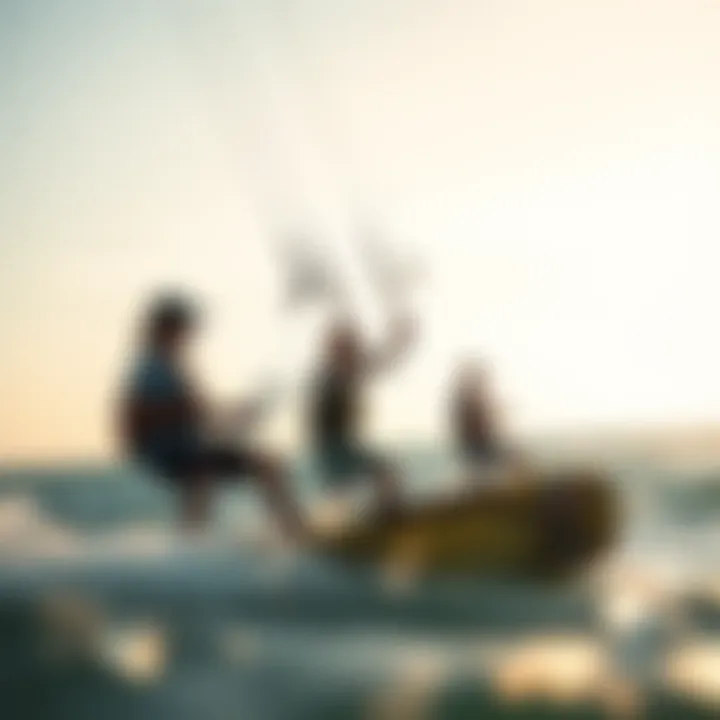
Assessing Weather Conditions
Before heading out, understanding weather conditions is pivotal in kiteboarding. Wind is your best friend when kiteboarding, but it can quickly turn into a foe. Here are a few things to keep in mind:
- Wind Speed and Direction: Wind details can vary significantly across locations. Familiarize yourself with your chosen kite area's wind patterns. Ideal conditions usually range from 10 to 25 knots for kiteboarding. Extreme winds can lead to dangerous situations, while too little wind can lead to frustrating rides.
- Weather Forecasts: Utilize reliable weather apps or websites like Wunderground to gauge current conditions and forecasts. Pay attention to any drastic changes in the weather.
- Local Hazards: Know your surroundings—are there rocks, piers, or shallow spots that could pose a risk while kiteboarding? These factors should heavily influence your decision to get out on the water.
- Tides: The state of the tides can impact wave conditions and the landscape of the beach. Check local tide charts before embarking on your kite journey.
Keeping an eye on these conditions can save you from unnecessary accidents.
Emergency Procedures
In kiteboarding, even seasoned riders must face unexpected situations. Knowing how to handle them can prevent minor issues from escalating into serious emergencies:
- Have a Plan: Always ride with a buddy or at least inform someone of your whereabouts and expected return time. Isolation can lead to unfortunate situations.
- Practice Self-Rescue Techniques: In case of a malfunction, knowing how to perform a self-rescue is invaluable. This usually entails detaching your kite and using it as a flotation device to paddle back to safety.
- Emergency Signals: Establish a set of signals with fellow kiteboarders for emergencies or trouble situations. Clear communication may save a life.
- Contacting Help: Familiarize yourself with local emergency services and have their contact info readily available. If you find yourself in a pickle, knowing whom to call can be crucial.
In summary: Safety is not just about dressing the part; it involves preparation, awareness, and the ability to think quickly on your feet. Equip yourself properly, understand the risks associated with your environment, and plan for emergencies to ensure your kiteboarding adventures remain exhilarating and safe.
The Future of Four-Line Kites
As the world of kiteboarding continues to evolve, four-line kites find themselves at a pivotal crossroads. The fusion of technology, environmental consciousness, and community shifts shapes the trajectory of these kites in ways that were previously unimaginable. Looking ahead, it’s essential to understand the specific innovations and practices that are steering the future of four-line kites, ensuring their relevance and versatility in an ever-changing landscape.
Innovations in Kite Technology
Advancements in kite technology have been nothing short of astonishing over the last few years. Manufacturers are experimenting with materials that enhance durability while reducing weight. For instance, fabrics like ripstop nylon have become common, offering robustness without sacrificing performance. Additionally, you'll see new advancements in the design of the control bar systems, improving responsiveness and control.
One significant innovation is the integration of digital technology. Kites are increasingly being designed with sensors that allow riders to track their performance in real-time. These sensors can measure speed, height, and even wind conditions, providing a data-driven approach to enhance performance. Riders can analyze their data through mobile applications, allowing for tailored feedback and improvement suggestions.
Main Points of Kite Tech Innovations:
- Use of lighter and stronger materials like ripstop nylon.
- Evolution of control bar systems for better handling.
- Real-time performance tracking through smart technology.
Sustainability Practices in Kite Manufacturing
In recent years, there has been a growing focus on sustainability across industries, and kiteboarding is no exception. Kite manufacturers are now aware of their environmental footprint and are taking meaningful steps toward eco-friendliness. For example, some companies are adopting eco-conscious materials in their products, such as recycled plastics in kite linings and packaging. This not only minimizes waste but also appeals to environmentally aware consumers.
Additionally, production processes are being refined to reduce energy consumption and waste. It's becoming more common for kites to be made in factories that adhere to strict environmental standards. This move not only helps the planet but also enhances the brand’s image in an increasingly conscious market.
"Sustainability is not just a trend; it is rapidly becoming a standard expectation among consumers, and kiteboarding is aligning with this shift."
Emerging Trends in Kiteboarding Communities
As kiteboarding continues to gain popularity, new trends in communities are surfacing, reshaping how enthusiasts connect and engage. Social media platforms have become vibrant spaces for sharing experiences, showcasing skills, and organizing events. For instance, local and international kiteboarding competitions are being livestreamed, allowing spectators and participants to engage from anywhere in the world.
Moreover, the rise of kiteboarding schools is encouraging newcomers. These schools often emphasize not only skill development but also safety and environmental awareness, shaping a holistic approach to the sport. Additionally, the growing focus on inclusivity in kiteboarding is resulting in more accessible gear and community events designed to welcome riders of all skill levels and backgrounds.
Key Trends Emerging in Communities:
- Increase in local and global kiteboarding competitions.
- Enhanced focus on safety and environmental education in schools.
- Greater efforts on inclusivity within the kiteboarding community.
In summary, as kiteboarding moves forward, four-line kites stand on the brink of numerous innovations that promise to reshape the sport. Through technological advancements, sustainability practices, and evolving community dynamics, the future of these kites looks not only promising but also aligns with broader trends embracing performance and environmental stewardship.
The End
In wrapping up our exploration of four-line kites, it's vital to understand how they stand out in the landscape of kiteboarding. The nuances in design and functionality not only enrich the riding experience but also open a realm of possibilities for both beginners and seasoned riders. These kites offer enhanced control, enabling riders to execute advanced maneuvers with precision. Their adaptability in varying wind conditions makes them a reliable choice for diverse water environments.
Recapping the Benefits of Four-Line Kites
The advantages of four-line kites are numerous and compelling. Here are some of the key benefits:
- Superior Control: With an extra control line, pilots can manage a wider range of kite movements, making it easier to navigate tricky conditions.
- Increased Stability: The structure of four-line kites adds to their stability, allowing for smoother flights even in gusty winds.
- Versatile Maneuverability: Riders can easily transition between different tricks and adjustments, from simple turns to complex aerial displays.
- Safety Mechanisms: Many four-line kites come equipped with safety features that enhance rider security, providing peace of mind while soaring across the waters.
These features collectively enhance the kiteboarding experience, translating to better performance on the water. As riders gain confidence and skill, the specific attributes of four-line kites can vastly improve their gameplay.
Encouragement to Explore Kiteboarding Further
Kiteboarding, with its thrill and challenge, is an adventure worth diving into. If you’re just getting started, take the leap and explore the world of four-line kites. Try different models, engage with the kiteboarding community, and don’t hesitate to ask questions or seek guidance. Clubs and online forums are brimming with seasoned veterans happy to share their wisdom.
Investing time in practice will yield a satisfying return as you learn the ropes. Remember, each session on the water offers new experiences and challenges that can sharpen your skills. Embrace those windy days and varying conditions; they provide the perfect backdrop to test your reaction and adaptability.















